the red-banded sand wasp
The sandwesp is a common wasp in North-Europe. They live solitary, and have a striking, easy to recognize appearance: a orange band around a very long “waist” of two segments.
These wasps are famous for there beheavior (brood parasitism and mass provision) and are remarkable for there good memory.
Mass provisioning
The red banded wasp stocks all the food for each of her offspring in a small chamber in a burrow before she lays the egg.
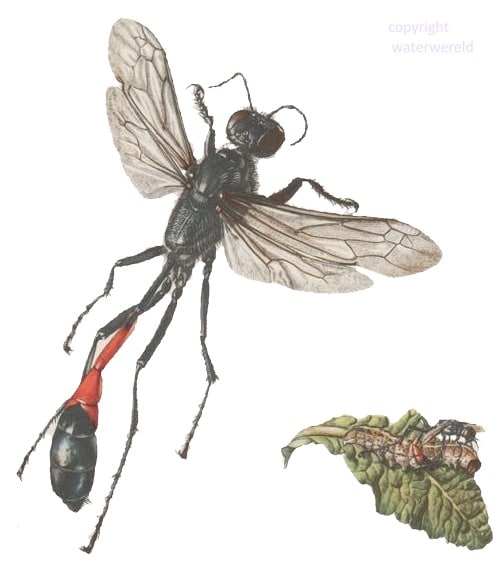
The red banded sand Wasp (female) on a print of Claus Caspari (1), also : paralyzing a caterpillar on a kale leave.
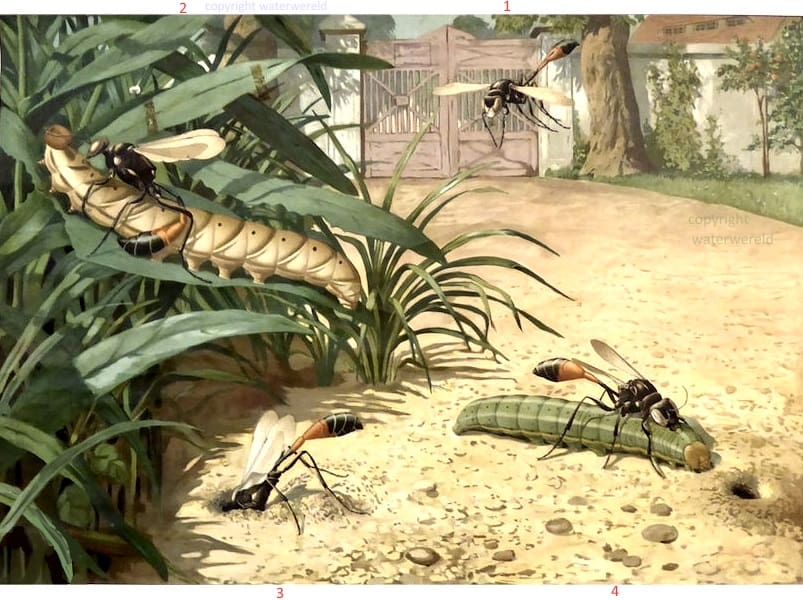 A old german book illustration (2) of the female red banded sandwasp:
A old german book illustration (2) of the female red banded sandwasp:
1 flying : the sandfly is a slow flyer.
2 paralyzing a lepidopteran caterpillar
3 digging a hole in the sand
4 transportation from a paralyzed caterpillar to the burrow.
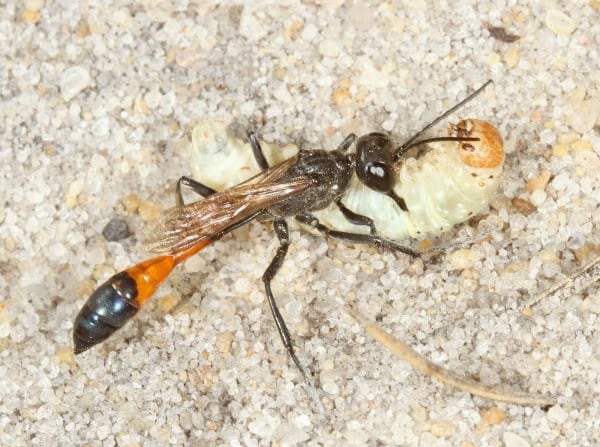
A female red banded sand wasp transporting the larva of a owl moth. These Noctoid moths larvae are transported with the belly up. they weight up to ten times the weight of the wasp.The redbanded sand wesp seems to favor the larvae of Anarta Myrtelli, the beautiful yellow underwing (4 ). Hunting is only done in periods of sunshine. A photo made by Jeremy Early(3).
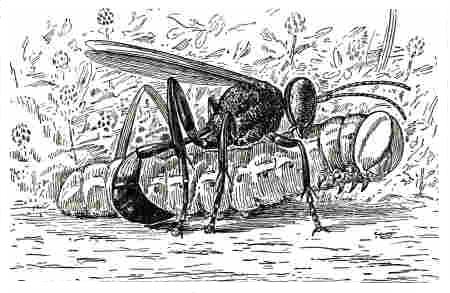
Hunting for caterpillars (5): The wasp first grabs the upper side of the caterpillar, and angles her long abdomen around under the caterpillar to sting it on its abdomen, in the midline and between the segments of the caterpillar, paralyzing it. If this isn’t done properly the caterpillar will die or tries to defend itself. (6)(7)
The nest of the red banded sandfly
A female may make up many nests. The nest is a hole in the ground , covered and closed with sand. It is filled with an large caterpillar or with many small ones. There are three dangers that threatens the nest: ants, stealing sand wesps and brood parasitism:
- – Ants
A red banded sandfly will kill every ant that nears the nest: Not to eat the ant but to prevent it signalling other ants.
- -Sand wesps
Other sandwasps often (try to) steal the caterpillar from each other.
- -Brood parasitism
Other female red banded sandfies lay their eggs on the catarpillar. But first they try to remove the already placed egg .

The female then starts by digging a burrow ,(1), starting by using the sharp mandibula. The sand is removed by the under part of the head (chin) .The tunnel is widened on the end , but not enough to make a turn , the red banded leaves the same way as it got in. (2) The paralyzed caterpillar is brought to the entrance (3), the burrow is closed, any nearby ants are killed (4). The redbanded got out , and will catch even more caterpillars. (5, 6) the burrow is sealed with laeger stones and sand is used as camouflage (7). The red banded sand wasp has to find the way to there camouflage burrow again. This is done by orienting on shrubs and trees. For this reason they need a good sight and memory and recognition of those plants.
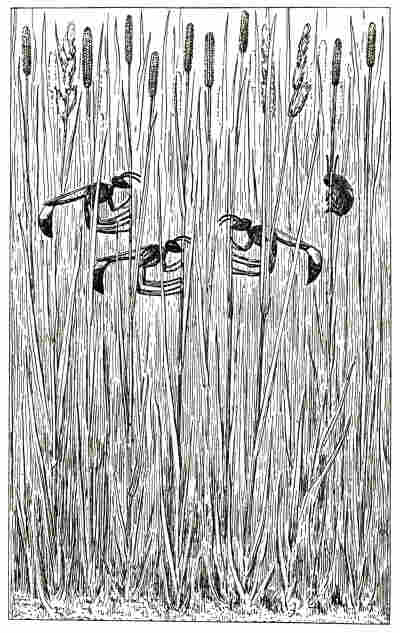
Sleeping red banded sand wasps. The red banded sand wasp feeds on flowers , feeding on honey with its long tongue. A large part of the day they rest on the leaves of grass. (5)
The sand wasps
The red banded sand wasp belongs to subfamily Ammophilinae or sandwasps: they make there burrow in the sand. They belong to the hunting wasps family Sphecidae, wasps with an wasp tail. These hunting wasps tend to nest in pre-existing cavities and practice mass provisioning, providing all the prey items prior to laying the egg.
Sources
1 Claus Caspari 1961 Paris. Caspari (1911-1980) was specialized in highly detailed and realistic scientific illustrations painted in the style of James Sowerby (photographic on a white background)
2 German schoolplate , before second world war, adapted and corrected.
3 Jeremy Early , photographer and chairman of BWARS, a society aims to promote the recording of Bees, Waps and Ants in Great Britain and Ireland.

4 Niko Tinbergen: In het vrije veld page 63-69
5 illustration made by James H. Emerton. Wasps, Social and solitary, George W. Peckham Elizabeth G. Peckham.
6 Observations made by mrs Peckham and Dr Peckham.On the Instincts and Habits of the Solitary Wasps (1898)
7 J.H. Fabre . Souvenirs Entomologiques Etudes sur l’instinct et les mœurs des nsectes .1879 Paris. page 116-220. This is first book describing the behavior of the sand wasps.
